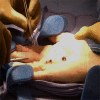Minimally invasive partial fasciectomy for Dupuytren's contractures
- PMID: 24294154
- PMCID: PMC3508008
- DOI: 10.1007/s11552-012-9461-x
Minimally invasive partial fasciectomy for Dupuytren's contractures
Abstract
Background: Numerous options exist for the treatment of Dupuytren's contracture. This study describes the technique and early results of partial fasciectomy through a mini-incision approach as an additional treatment option for Dupuytren's disease.
Methods: This procedure involves the excision of diseased Dupuytren's tissue with the use of multiple 1 cm transverse incisions. Patient demographics, digit involvement, the number of incisions required to release each digit, and complications were recorded for all patients. Range of motion data was obtained from a subgroup of patients that had at least 6 months of follow-up. A paired t test was used to compare preoperative and postoperative contracture.
Results: Sixty-seven patients underwent 75 procedures that involved 119 digits. The mean patient age at the time of surgery was 63 years (range, 33-95 years). A total of 32 digits (47 joints) were available for range of motion analysis. After a mean of 2.2 years following surgery, metacarpophalangeal joint contractures maintained correction (34° preoperatively, 19° postoperatively, p = 0.008). After a mean postoperative duration of 2.0 years, proximal interphalangeal joint contractures trended worse than preoperative levels (39° preoperatively, 45° postoperatively, p = 0.319). There was one major complication, which consisted of a nerve laceration that was identified and repaired intraoperatively.
Conclusions: Partial fasciectomy through the described mini-incision approach provides an additional surgical option for patients who desire a less invasive surgical procedure than traditional fascietomy. Although this procedure is safe and effective at achieving immediate cord release, maintenance of correction for proximal interphalangeal joint contractures remains problematic.
Keywords: Dupuytren’s contracture; Fasciectomy; Minimally invasive.
Figures



Similar articles
-
Severe contractures of the proximal interphalangeal joint in Dupuytren's disease: combined fasciectomy with capsuloligamentous release versus fasciectomy alone.Plast Reconstr Surg. 1996 Mar;97(3):560-6; discussion 567. doi: 10.1097/00006534-199603000-00011. Plast Reconstr Surg. 1996. PMID: 8596787
-
Minimally invasive technique for release of Dupuytren's contracture: segmental fasciectomy through multiple transverse incisions.Hand (N Y). 2011 Sep;6(3):256-9. doi: 10.1007/s11552-011-9336-6. Epub 2011 Apr 30. Hand (N Y). 2011. PMID: 22942848 Free PMC article.
-
A randomised feasibility trial comparing needle fasciotomy with limited fasciectomy treatment for Dupuytren's contractures.Pilot Feasibility Stud. 2020 Jan 30;6:7. doi: 10.1186/s40814-019-0546-y. eCollection 2020. Pilot Feasibility Stud. 2020. PMID: 32021696 Free PMC article.
-
[Operative treatment of Dupuytren's contracture : Arthrolysis of the proximal interphalangeal finger joint].Orthopade. 2017 Apr;46(4):328-335. doi: 10.1007/s00132-017-3387-5. Orthopade. 2017. PMID: 28175957 Review. German.
-
Cost-effectiveness in the management of Dupuytren's contracture. A Canadian cost-utility analysis of current and future management strategies.Bone Joint J. 2013 Aug;95-B(8):1094-100. doi: 10.1302/0301-620X.95B8.31822. Bone Joint J. 2013. PMID: 23908426 Review.
Cited by
-
Dupuytren's Disease: A Novel Minimally Invasive Pull-Through Technique.Arch Plast Surg. 2024 Mar 4;51(3):295-303. doi: 10.1055/s-0043-1775882. eCollection 2024 May. Arch Plast Surg. 2024. PMID: 38737838 Free PMC article.
-
Examining the efficacy and maintenance of contracture correction after collagenase clostridium histolyticum treatment for Dupuytren's disease.Hand (N Y). 2013 Sep;8(3):261-6. doi: 10.1007/s11552-013-9524-7. Hand (N Y). 2013. PMID: 24426932 Free PMC article.
-
Mini-Open Partial Fasciotomy for Dupuytren Contracture: Time to Reintervention.Hand (N Y). 2025 Jun 17:15589447251339504. doi: 10.1177/15589447251339504. Online ahead of print. Hand (N Y). 2025. PMID: 40524562 Free PMC article.
References
LinkOut - more resources
Full Text Sources

